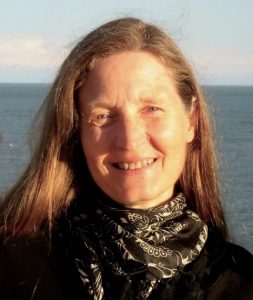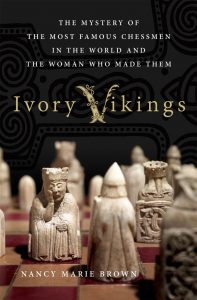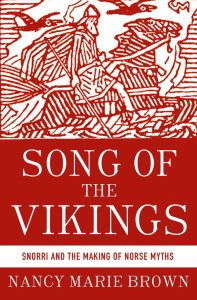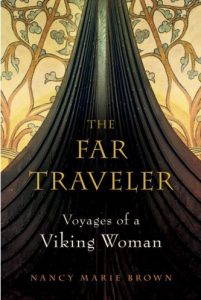Telling Women’s History: three Questions and an Answer with Nancy Marie Brown
Nancy Marie Brown and I first made contact when I was poking around the medieval world, working on the question of how Islam kept the flame of classical civilization alive and helped shape the culture of the West. That book never saw the light of day, but Nancy and I stayed in touch. We finally met in real life in 2015, when My Own True Love and I took her Icelandic history and culture tour. (If you’re interested in knowing more about that, you can take a dive in the archives for August of that year. The short version? It was wonderful.)
Nancy is the author of five general interest books and one young adult novel about Iceland and the medieval world: Ivory Vikings: The Mystery of the Most Famous Chessmen in the World and the Woman Who Made Them (published in September 2015), The Saga of Gudrid the Far-Traveler (the novel; published in June 2015), Song of the Vikings: Snorri and the Making of Norse Myths (2012), The Abacus and the Cross: The Story of the Pope Who Brought the Light of Science to the Dark Ages (2010), The Far Traveler: Voyages of a Viking Woman (2007), and A Good Horse Has No Color: Searching Iceland for the Perfect Horse (2001).
Her books combine extremes: medieval literature and modern archaeology, myths and facts. They ask, What have we overlooked? What have we forgotten? Whose history must not be lost?
For 20 years, Nancy worked as a science writer and editor for Research/Penn State magazine, published by Penn State University. She is also the coauthor, with geneticist Nina V. Fedoroff, of Mendel in the Kitchen: A Scientist’s View of Genetically Modified Foods (2004).
She holds a B.A. in English (from the Writing Option, 1981) and an M.A. in Comparative Literature (with emphases in Arthurian Romance and Icelandic Saga, 1984), both from Penn State. She turned to writing books full time in 2003, when she moved to a farm in northern Vermont where she and her husband, author Charles Fergus, keep four Icelandic horses and an Icelandic sheepdog. She spends part of each summer in Iceland, offering a history and culture tour in collaboration with the company America2Iceland.
What’s your next book about and when is it coming out?
I’m currently working on the story of a Viking warrior buried in Birka, Sweden in the 10th century. When DNA tests in 2017 revealed the skeleton was female, the scientific study sparked enormous popular interest and an equal amount of backlash from people who doubted Viking women could attain the level of military excellence represented by what was found in this grave: an axe, two spears (one long-hafted, one short), a two-edged sword, a clutch of armor-piercing arrows, their shafts embellished with silver thread (the bow decayed to dust), a long sax-knife in an elaborate sheath, a shorter knife, a whetstone, two round shields with iron bosses, a large bronze bowl, a comb, a set of elk-antler gaming pieces (placed in her lap), three traders’ weights, a crystal bead, a silver coin, two stirrups, bridle bits, and spikes to ride a horse on the ice, along with two horses, a stallion and a mare. She was buried with more weapons than any other warrior in Birka; more than almost every Viking in the world. Of those Vikings found buried with any weapons at all, 61 percent have one weapon; only 15 percent have three or more.
Until the DNA tests proved the bones were a woman’s, this grave, numbered Bj581, was held up as the classic Viking warrior’s grave. “The position of the skeleton,” wrote an expert in 1966, “gave the impression that he had been sitting in the grave, rather than laid out. … The equipment indicates that this is a warrior’s grave rather than that of a merchant. The skeletons of two horses found in the eastern side of the grave outside the actual ‘chamber’, and the presence of stirrups, make clear that he was a horseman. The date of a silver coin, found underneath the skeleton of the dead man, provides a fairly good idea of the date of the grave: 913-980 A.D.”
Since 2017, when the DNA study turned “the dead man” into a dead woman, we’ve struggled with the implications. A burial with weapons and horses, we thought as late as 2008, used “a widely recognised symbolic language of lordship, one that was unquestionably masculine,” as one scholar put it. But to assume that all such “weapons graves” are male, it now seems, is a mistake—and one that’s skewed our image of the Viking world.
In my next book, tentatively titled “The Valkyrie,” I take the liberty of naming the skeleton in Bj581 “Hervor,” after several famous warrior women in Old Norse poetry and sagas. By reconstructing this Hervor’s life and times, using what archaeology can tell us about her skeleton and her grave goods and comparing that information with what we can glean from Old Norse literature and mythology, I reveal that Viking women had more power and agency than historians have yet imagined.
Valkyries, shield-maids, and other Viking women with weapons have, until now, been explained away as symbols or myths or modern feminist wish-fulfillment. And yet, the sources that depict women with weapons—the images, the Christian-era texts, the ambiguous burials like Bj581 and the stray archaeological finds—are the exact same sources we have for the history of Viking men. To write a history of the Viking Age at all means to read between the lines. To make educated guesses. To interpret and to speculate. To imagine what might have been. What would the Viking world look like if roles were assigned, not according to modern (or nineteenth-century) concepts of male versus female, but based on ambition, ability, family obligations, and wealth? In “The Valkyrie,” inspired by a warrior’s bones, I investigate that world. “The Valkyrie” will be published in 2020 by St. Martin’s Press.
links:
scientific study
https://onlinelibrary.wiley.com/doi/epdf/10.1002/ajpa.23308
backlash
http://norseandviking.blogspot.com/2017/09/lets-debate-female-viking-warriors-yet.html
What do you find most challenging or most exciting about researching historical women?
In spite of what most people may think, history books and books of non-fiction in general are not “true.” They do not, and cannot, capture the totality of what happened in any one place or time. Historians choose what to tell and what to leave out. That choice is an interpretation.
But the process of interpretation only begins there. History books are not collections of facts; they are not lists. They are stories that stitch a set of facts together. The more facts, the closer the story may approach reality. But no matter how many facts a historian recounts in her book, it remains a story—an interpretation. And as such, it reflects her cultural biases.
Until very recently, one of those cultural biases was to ignore women. “The history of the world is but the biography of great men,” the Victorian philosopher Thomas Carlyle proclaimed in 1840 upon reading Heimskringla, the history of the kings of Norway written by the thirteenth-century Icelandic chieftain Snorri Sturluson. Snorri likely would have agreed with Carlyle, especially with his emphasis on men—Snorri included very few women in his sagas.
But Snorri did include some women—and very powerful women at that. The challenge in writing about women of the Viking Age or medieval Iceland, as I do, is not so much finding them, but in stripping away the layers of interpretation that have grown up around them.
Today our facts about women in Viking Age or medieval Scandinavia come from two sources: written texts and archaeology. We have Icelandic and Old Norse histories, laws, sagas, poetry, and myths describing the lives of these women, but the manuscripts still extant were written in the 1200s about women who (may have) lived in the 800s or earlier. Separating fact from fiction in these written texts is a matter of interpretation. We also have museum pieces and archaeological finds, discovered and analyzed over a period of hundreds of years using a variety of techniques. Again, deriving a set of facts from an object or an archaeological investigation is a matter of interpretation. We know the object exists, but do we know what it meant to the people of the Viking Age?
Why is it important to write the stories of medieval Icelandic or Norse women today?
Let me give you an example. The Viking Age, I was taught, was an era of strict gender roles. The woman ruled the household: Her domain was innan stokks, “inside the threshold.” She held considerable power, for she controlled clothing and food. In lands where winter lasts ten months and the growing season only two, the housewife decided who froze or starved. The larger the household, the more complex her job. Managing the household of a chieftain who kept eighty retainers, as well as family and servants, was like running a small business.
But for all that, the man held the “dominant role in all walks of life,” I was taught. His duties began at the threshold and expanded outwards. His was the world of public affairs, of “decisions affecting the community at large.” He was the trader, the traveler, the warrior. His symbol was the sword.
The woman’s role, in turn, was symbolized by the keys she carried at her belt.
Except she didn’t.
There are a hundred and forty extant medieval Icelandic sagas; only one, recounting a feud from 1242, refers to a housewife’s keys. A Danish marriage law from 1241 says that a bride is given to her husband “for honor and as wife, sharing his bed, for lock and keys, and for right of inheritance of a third of the property.” A bawdy poem, in an Icelandic manuscript dated after 1270, describes the hyper-masculine Thunder god, Thor, dressed up as a bride with a ring of keys at his belt. These texts might reflect a pagan Norse truth. They might equally reflect the values of medieval Christian world in which they were written. We can’t tell.
What the keys do reflect are the values of nineteenth-century Victorian society, when upperclass women were confined to the home and told to concern themselves only with children, church, and kitchen. The first Viking housewife with her keys appears in Swedish history books in the 1860s, replacing an earlier historical portrait of Viking women who were strikingly equal to Viking men. The Victorian version of Viking history has been presented since then as truth, but it is only an interpretation.
Surely archaeology backs up the well-known image of the Viking housewife with her keys, you insist. It does not. Keys have been found in some women’s graves. But they are not common, nowhere near as common as housewives. Against the three thousand Viking Age swords that have been found in Norway, a Norwegian archaeologist in 2015 sets only 143 keys, half of which were found in men’s graves. A researcher in Denmark in 2011 found only nine out of 102 female graves she studied contained keys, and none of these “key graves” otherwise fit the model of “housewife.”
Calling keys the symbol of a Viking woman’s status, these and other researchers now say, is “an archaeological misinterpretation,” “a mistake,” “a myth”—and a dangerous one. By accepting the nineteenth-century stereotype of men with swords and women with keys, archaeologists legitimize the idea that women should stay at home. They reduce the role models for every modern girl who visits a museum or reads a history book. They make it easy, for example, for scholars to dismiss as unrealistic the warrior women found in every kind of medieval text that depicts Viking society—history, law, saga, poetry, and myth—and, since the 2017 the DNA test of the warrior in grave Bj581 in Sweden, attested to archaeologically.
links:
Norwegian archaeologist in 2015 :
https://www.academia.edu/15598703/The_symbolism_of_keys_in_female_graves_on_Zealand_during_the_Viking_Age
researcher in Denmark in 2011
https://www.academia.edu/10177320/Truth_and_reproduction_of_knowledge._Critical_thoughts_on_the_interpretation_and_understanding_of_Iron-Age_keys
Question for Pamela: Who is the Viking warrior woman in your new book, Women Warriors, and how did you uncover her story?
I deal with the Birka Woman and the women buried with the Oseberg ship as part of a larger discussion of the ways in which archaeologists have historically assumed that sword=male, and the twisty thinking that has resulted when they have been forced to admit that female remains were buried with weapons. Like Nancy, I spent a lot of time reading archaeologists’ reports, though I probably struggled more than she did with the scientific details.
Interested in learning more about Nancy Marie Brown and her work?
Check out these websites:
Nancy Marie Brown: https://www.nasw.org/users/nmb/index.html
America2Iceland: http://www.america2iceland.com/trips/sagas-and-vikings/
(Drop in tomorrow for another Telling Women’s History interview. I’ve got an entire month of some of my favorite history people talking about the work they do and how they do it. Next up: Paula Tarnapol Whitacre, A Civil Life in an Uncivil Time.)









What fascinating research! And thank you for providing links — I am eager to share these readings in my Women in the Ancient World (world civ) class.